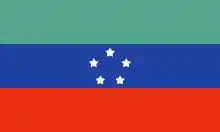2019 Sidama Region referendum
A referendum on the creation of a Sidama Region was held on regionalisation in the Sidama Zone of Ethiopia on 20 November 2019.[1][2] The creation of such a region is a long-standing claim of the Sidama people.

 |
|---|
| This article is part of a series on the politics and government of Ethiopia |
| ||
| Location | Sidama Zone | |
|---|---|---|
| Results | ||
The management of the referendum and its likely centrifugal consequences on Ethiopia's system of ethnic federalism is seen as a crucial test for Prime Minister Abiy Ahmed's policy of democratic openness ahead of the 2020 general election.
Results
| Choice | Votes | % |
|---|---|---|
| 2,225,249 | 98.52 | |
| Against | 33,463 | 1.48 |
| Blank and invalid votes | 18,351 | – |
| Total | 2,277,063 | 100 |
| Voter turnout | 2,280,147 | 99.86 |
| Source: Addis Standard | ||
The choices on the ballot paper were for the Sidama people to be organized within their own regional state, which was represented by the election symbol of “Shafeta” (traditional Sidama food vessel) and for Sidama to stay in the Southern Nations, Nationalities, and Peoples' Region (SNNPR), represented by the “Gojo” (traditional Sidama hut) symbol. The latter choice got a very small percentage of votes, an expected result given the popularity of the decades-long statehood quest among the Sidama and the lackluster campaigning by the SNNPR.
The result means Sidama will become Ethiopia's 10th semi-autonomous regional state, with its own regional constitution and regional council, enjoying a degree of sovereignty enshrined in Ethiopia's multinational constitution.
The Sidama regional state, the 10th regional state which will be carved out of Sidama Zone, will border Guji Zone and West Arsi Zone of the Oromia Region as well as Wolayita Zone and Gedeo Zone of the SNNPR.
The question of what to do about the city of Awasa in Sidama Zone, which is also the capital city of the SNNPR but would be outside of the region when the Sidama state is officially declared, was a sticking point for sometime, but was addressed when the regional council decided that the SNNPR government would stay in Awasa for two consecutive election terms during which it would facilitate its own future capital city.
The 20 November referendum came five months after it was constitutionally mandated to have been held, an anomaly that was met with a bout of violence resulting in dozens of deaths in July 2019.
This also resulted in giving hope to other ethnicities belonging to the SNNPR party in order to strive and achieve statehood as the Sidama in fact did.
References
- Ethiopia: Sidama's self-determination referendum set for Nov. 20
- "Hope, uncertainty as Ethiopia's Sidama gear up for statehood vote". www.aljazeera.com. Retrieved Nov 20, 2019.